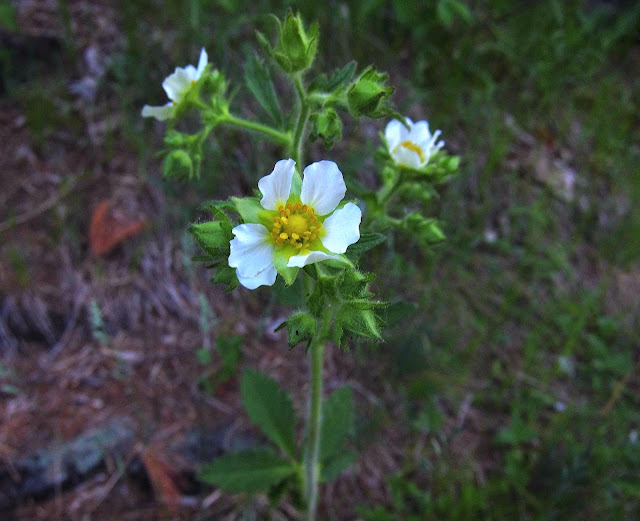Those massive heaps of a particular kind of ice called "frazile" are what suppress the woody growth that would otherwise shade the grassy flat areas leading down to the water's edge. And it's here among the low shrubs and native grasses that we find some of our state's rarest flowers, including the tiny plant called Sticky Tofieldia (Triantha glutinosa), a species ranked as Endangered in New York. Although this plant is very small, we could easily spy abundant numbers of the bright-white flower clusters and rosy seedpods scattered in damp sand along the shore.
We could also easily spy the bright-yellow blooms of Frostweed (Crocanthemum canadense) thriving in the sandy soil, a flower remarkable for the way its orange-tipped anthers often seem to flop to one side.
Growing higher up on the banks and swaying above the tall grasses on even taller stems, Tall Cinquefoil (Drymocallis arguta) lifted its snowy blooms. Another name for this native plant is Tall Wood Beauty, but I have never seen it blooming in the shade of the woods, but always in sunlit roadsides or on open river shores like this one along the Hudson.
A number of native orchids can be found along these shores, and the little Rose Pogonia (Pogonia ophioglossoides) is not only one of the prettiest , it is also one of the most common of New York's orchids. That was certainly true today. Although we frequently find Shining Ladies' Tresses, Tubercled Orchids, Ragged Fringed Orchids, and Smaller Purple-fringed Orchids at this site, the Rose Pogonia was the only orchid species we found today.
The fragile-looking little Bedstraw Bellflower (Campanula aparinoides) is very small, but its pale-blue flowers stand out amid the other vegetation this weak-stemmed plant must lean on to hold its flowers above the ground.
The deeper-blue Harebell (Campanula rotundifolia) has flowers that look almost as fragile as those of the smaller bellflower pictured above, but this is really one tough plant, thriving as it does on the sun-baked, thin-soiled rocks that are its favored habitat. I love how the sunlight illumines the translucent flowers as if they were tiny lanterns.
Creeping Spearwort (Ranunculus flammula var. reptans) is a very tiny flower, but its shiny, bright-yellow blooms shine out from among the riverside grasses like stars from the dark sky.
As we ventured upstream along the shore, we came to an area where spring-fed pools filled the hollows in the rocks.
The tiny Racemed Milkwort (Polygala polygama) was hiding out among these rocks, but its bright-purple color made its presence easy to detect.
There was NO chance we would miss seeing the lovely Carolina Rose (Rosa carolina),with its large bright-pink blooms springing up from cracks in the rocks. This rose can be distinguished from other low-growing wild roses by its narrow stipules and straight, slender thorns. It is as fragrant as it is beautiful.
Several of the pools in this area of the Ice Meadows showed evidence of acidity by the presence of such bog-dwelling plants as this Round-leaved Sundew (Drosera rotundifolia). The shining droplets that tip the hairs of each leaf are actually quite sticky, capturing insects drawn to what looks like easily accessed nectar, only to be trapped and consumed by the leaves that close over them.
The similar Spatulate-leaved Sundew (Drosera intermedia) also shares these pool edges, attracting and trapping insects in the same way as the Round-leaved Sundew. Apparently, the wings of insects are not digestible by these plants, for I often see their glossy remains scattered among the stems.
Another bog-dweller abundant around certain pools was this species of Cranberry, bearing white flowers with sharply reflexed petals. I can't recall if this is the Large Cranberry (Vaccinium macrocarpon) or the Small Cranberry (V. oxycoccos), since their flowers are basically identical.
I was truly surprised to find these Blue Flags (Iris versicolor) still in bloom, since this species of native iris has long since faded and gone to seed down in Saratoga County. But I think its late blooming time has less to do with being further north than it does with how the ice heaps deposited here each winter don't completely melt until well into June some years. So what would normally be spring bloomers often don't bloom on the Ice Meadows until well into summer.
Late-melting ice heaps could also explain the presence now of Wood Lilies (Lilium philadelphicum) just starting to bloom on the Ice Meadows. Again, this beautiful native wildflower, long gone to seed in other areas of the state, was only now lifting its spectacular blooms to the sky.
The ice deposits and consequent winter flooding were particularly damaging last winter, as were violent spring floods that raged through this river valley in late May, ripping vegetation from its roots and later depositing the flotsam on the riverside boulders. We could see evidence of those events still, where the shoreline boulders were strewn with what looked like thick mats of straw.
Here is an even more striking example of how furious the flooding was last winter. The force of the raging floodwater gouged out half of what used to be the River Road that followed the west bank of the Hudson from Thurman to The Glen. Since this road can not be rebuilt at this site, a new road will have to be constructed further back into the forested shore. That will take a long time. Although some Ice Meadows plants were destroyed in these same floods, it is likely their roots or seeds are still present in the soil, and so they will probably regrow. Unfortunately, the same cannot be said for this destroyed bank.


















1 comment:
Wow, what an abundance of bloom. Excellent photos. That was certainly a fascinating visit.
Post a Comment